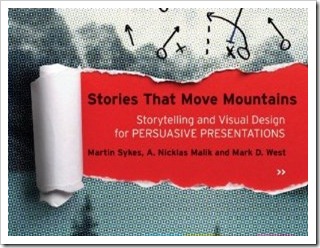The Story behind “Stories That Move Mountains”
There is a new book available that I’d like to let everyone know about. It is called “Stories That Move Mountains.” I wrote this book with two fantastic professionals Martin Sykes and Mark D. West. In this post, I’m going to talk about how this book came to be, and why I felt so strongly about it that I invested two years of my life in bringing it to market.
First off, if you are interested in buying the book, and we think you will be, you can click on the image of the cover to take you straight to our “buy the book” page on the book’s sister site, StoriesThatMoveMountains.com.
Edward Tufte and Me
My journey into “rich information” began, as it did many others, when I heard about a book called “Visual Explanations” written by Edward Tufte. It was 1997, and the dot-coms were booming. I had left Microsoft to stake a claim in the modern gold rush. I was working as a development manager in a quickly growing web development company in downtown Seattle called Fine.com International. (see note)
On my team was a talented young web developer named Brian Poel who told me about a seminar he attended hosted by Tufte. In the seminar, Tufte taught about creating visual designs that inform, not just impress. Brian showed me the materials and I ended up reading Tufte’s book myself (Another bit of evidence to support the old saying: a manager is only as good as the smart people that surround him).
At fine.com, we used the techniques described by Tufte in every way we could. His guidance led to design ideas that fed into the Nasdaq.com web site, the Marriott hotels web site, and many more. I learned the power of structuring information in a way that makes it easy to consume, elegant to perceive, and compelling to read.
It would be many years before I needed these techniques myself. That didn’t really start until I became a management consultant. The year was 2001, and the dot-com that I co-founded after leaving fine, Acadio, had failed along with tens of thousands of other young start-ups. I had moved to a consulting company called Sierra Systems Group (headquartered out of Vancouver British Columbia) to make ends meet. For the most part, I focused on technology activities, but I had to ramp up my communication skills. So I started using some of the rich information techniques that I learned from Tufte in our marketing and sales materials. I cannot say that I was particularly good at it.
I Can’t Draw… Seriously
I really can’t. Not even stick figures. Which is odd, because both of my parents, my eldest brother, and my daughter, are all gifted artists. Not that I can’t create useful diagrams… I had trained in high school as a draftsman. Give me a T-square, two triangles, a nice drawing board, and couple of sheets of vellum and I can draw a complete set of floor plans for your house (well… I could in 1980… maybe not so much now). But freehand, I am hopeless.
So when I tried to create a nice visual representation, and failed, I thought it was because of my lack of skill as an artist. I couldn’t have been more wrong. Regardless, the best I could do, at the time, was to follow the guidance in “Beyond Bullet Points” and create PowerPoint presentations that were compelling using emotive photographs. They were nice, but they weren’t the things I wanted to create.
Meanwhile on the other side of the Atlantic
Turns out, I was part of movement of sorts. A growing number of people had taken up the challenge of creating interesting visual representations of complex information. The “infographic” movement had started, and companies were springing up here and there to provide clear, simple, and compelling explanations of complex information. On the other side of the world, in the UK, an enterprise architect named Martin Sykes had begun his own journey, around the same time as I had. Big difference: he didn’t give up.
If you ever get a chance to meet Martin, you will enjoy his company immensely, just as I do. Martin is clever, thoughtful, easy-going, and funny. He’s a systems-thinker and an excellent speaker. Martin was also influenced by Tufte, but he continued on to find many other authors and designers who were publishing and writing about this new way of doing things. Martin started creating his own single page explanations of otherwise complex information, building up his skills and collecting techniques along the way. And, Martin took the time to learn how to draw. That didn’t hurt.
I met Martin Sykes through a mutual friend, Gabriel Morgan. Gabriel had joined the Enterprise Architecture team in Microsoft IT just a few months after I did, but he came to the practice from his work as a consultant using Microsoft Motion (later renamed Microsoft Services Business Architecture or MSBA). Gabriel had met Martin a few times, and had seen some of the visualizations that Martin used to explain business architecture. Gabriel worked with Martin to set up a workshop, for our team, to learn some of these skills. And in late October of 2007, Martin flew to Redmond and spent a week teaching us how to “tell stories” using a series of visual metaphors. At the time, he called them “Big Pictures” but that thinking evolved and we now refer to these creations as “visual stories”.
Can we do this again?
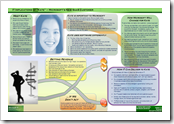 During Martin’s workshop, each of us created a visual representation of some idea or story we wanted to tell. Martin had distilled his own personal techniques into a FIVE DAY COURSE on creating visual stories. He walked us through ample examples, storytelling exercises, and a fairly simple process that he used to create visual stories. I created two visual stories in that class, one of which Martin still uses today… as an example of what NOT to do in a visual story!
During Martin’s workshop, each of us created a visual representation of some idea or story we wanted to tell. Martin had distilled his own personal techniques into a FIVE DAY COURSE on creating visual stories. He walked us through ample examples, storytelling exercises, and a fairly simple process that he used to create visual stories. I created two visual stories in that class, one of which Martin still uses today… as an example of what NOT to do in a visual story!
The five day class happened once. Over the next few years Martin did four one day classes at different companies where he had been asked specifically to do more following a series of 90-minute presentations he had done at internal and external conferences. But the ideas were not “catching fire”, in large part because Martin was just happy to use what he was learning and focus on his day job of making change happen.
Meanwhile, I kept using his materials, and referred often to the binder full of PowerPoint slides that he provided. I practiced a few times more, and then stumbled into success. I created a visual story to explain an enterprise architecture roadmap to the Vice President of Operations. I presented the one page visual, and the meeting went fairly well. We got the sponsorship we needed. What I didn’t discover until later: that same Vice President took my one-page presentation and gave it to Steve Ballmer, CEO of Microsoft and one of the most powerful businessmen in the world, to explain how Microsoft’s Operations Division was attacking a key problem within the company.
That single page told a story. It was not a bunch of data. It was not a bunch of clever graphics. There was no hand-drawn art. It was a careful construction created using Martin’s techniques, and it changed my career. I was promoted and over time, I was leading a team. I wanted to bring Martin back to our group to do another one of these fantastic workshops, so that more of us could learn his techniques. I was willing to teach it myself if I had to.
A book is born
My goal was to put on a workshop for the entire Enterprise Architecture team within Microsoft IT. I reached out to Martin and asked if he had ever updated those PowerPoint slides. Thus began a series of meetings that morphed into a book proposal. We planned to create something visually interesting, to use our own ideas to tell the story of how use these ideas. Martin reached out to a friend of his, Mark West, a talented artist and designer that had worked with Martin on creating some of his training materials. Mark was familiar with the process because Mark had lived it. And he can draw. (I’m understating rather wildly. Mark has spent time as an art instructor at a college in Seattle, in addition to running his own design firm. Mark is a change agent who masquerades as a very cool designer.)
During those early days, we simplified and clarified the process of creating a visual story, and we called it “CAST.” CAST is an acronym for “Content, Audience, Story, Tell” which are the four stages of the process. We created a simple “canvas” that anyone can use. During this past year, Martin has put together a couple of workshops in other parts of the company and has used them to work out the bugs. We call this canvas the “CAST model” and I have completely adopted it. It’s like a simple visual checklist that helps you remember and iterate through the steps to creating a visual story.
We still haven’t done that workshop for Microsoft IT. We decided to create a book that we could both use to teach anyone we wanted. We decided to focus on using these skills to simplify the process itself, and to make it easy for folks who, like me, are not artists. Note: in a professional setting, on projects that are funded to create compelling information, I strongly recommend enlisting the help of a visual designer… but for your own use, to explain your own information, you can follow the CAST process to do the trick. Just like I did.
The long slog
Anyone who walks the road from idea to a complete book knows that it can be a difficult and time-consuming effort. We had our moments when each of us thought that this whole thing was nuts. After all, there were so many good books already on business storytelling and good design principles. Couldn’t someone just read those books?
They could, but what I got from Martin, in that workshop in 2007, was not in any of those books. Martin didn’t change my career with a collection of art tricks and bits from a dozen books. What Martin gave me, and what we wanted to give our readers, is a simple step-by-step process that a non-designer could follow to create a USEFUL and COMPELLING single-page visualization. Not high art. High value.
We knew we had something unique… something that none of the other books and authors and workshops had built. We had something that the non-artists among us could use to be compelling and useful. We had a book about change, and making change happen. We had a book about stories, and using those stories to drive big changes, huge changes… using those stories to MOVE MOUNTAINS.
Most of the text was written between November of 2011 and May of 2012. Most of the artwork that infuses this book, on every single page, was created in the spring and summer of 2012. The book is compelling and visually beautiful. We treated every single pair of pages as a two-page layout, and each was hand constructed by Mark West. Our publisher, Wiley and Sons, created a new team, with about twice the normal book staff, just to assemble it. Wiley knew we had something unique, and they were willing to take a real risk on it. Our team at Wiley did a fantastic job. I’ve been a co-author before, but never had an experience anything like this one. The level of communication, collaboration, and shared iterative design was simply unprecedented. The Wiley team moved a mountain as well.
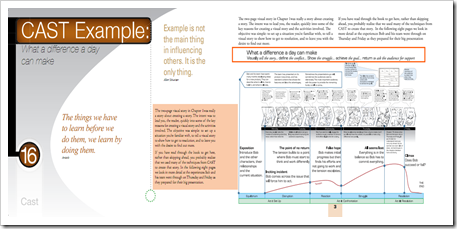
Sample of a two-page spread used in the book Stories That Move Mountains
What you will get out of this book
In case it’s not clear already, we want this book to be practical and useful. This is NOT an art book, even though there is one chapter that focuses on detailed visual elements like fonts, colors and layouts. This is not a typical business book either. There are no long expositions on financials or sales strategy or performance measurement. This is a book about change, and it is for ANYONE that wants to influence another person to lead a change.
What you will get out of this book is a step-by-step process to follow that results in a visual story. We walk you through numerous examples, showing how we use the CAST stages to create visual stories and there is a final chapter that literally goes end-to-end in creating another visual story. We provide advice, and hugely valuable nuggets from a dozen other books that fill out shelves in mine and Martin’s and Mark’s libraries.
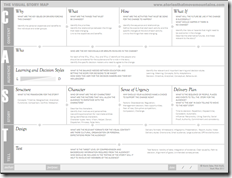 Our references chapter is also a simple, clear, layout that focuses on a small and manageable list of excellent books for you to use if you want to “go deep” on any part of the process (you won’t have to, but just in case you want to). We are also committed to continuing the conversation on the book sister-site https://StoriesThatMoveMountains.com where all three of us blog and upload resources (including a downloadable CAST model template, like the one on the right). You can also find us on Facebook for a more socially-oriented conversation (www.facebook.com/storiesthatmovemountains) as well.
Our references chapter is also a simple, clear, layout that focuses on a small and manageable list of excellent books for you to use if you want to “go deep” on any part of the process (you won’t have to, but just in case you want to). We are also committed to continuing the conversation on the book sister-site https://StoriesThatMoveMountains.com where all three of us blog and upload resources (including a downloadable CAST model template, like the one on the right). You can also find us on Facebook for a more socially-oriented conversation (www.facebook.com/storiesthatmovemountains) as well.
It should come as no surprise that both Martin and I are Enterprise Architects. The biggest value we offer our clients is helping them to build the case for change. But change can be anything. You could be changing a business, or a team, or a family, or even yourself. You can create a visual story for nearly any situation where you want people to remember, and connect, with your case for change.
Yep, it still works
I’ll give you an interesting example. I am currently volunteering my time to a professional organization called the “Center for the Advancement of the Enterprise Architecture Profession” (or CAEAP, pronounced “seep”). Through that organization, I have been assigned, by CAEAP, to work with another professional organization that they partner with: the “Federation of Enterprise Architecture Professional Organizations” (or FEAPO, pronounced “FEE-poe”). I’m working on creating an industry-wide perspective on Enterprise Architecture. I went to a FEAPO meeting just last weekend where I was working with people, in person, that I’ve only met one time before. They were all aware of my project, of course, but it was not, and is not, their primary focus. I couldn’t be sure that they remembered anything from the last time we’d met, in February. I decided to use a visual story to frame what would have otherwise been a boring status update.
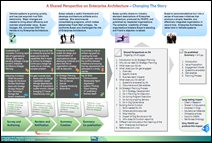 On the plane flight from Seattle to Fort Lauderdale (five hours in coach, on a red-eye overnight flight), I filled out the CAST model and created the entire presentation. (I had no internet access on the plane, so the graphic images I used were all on my PC hard drive). The moment I landed, I drove to FedEx Kinkos, printed the visual story on nice, sturdy, 11x17 paper, and drove straight to the 8:30am meeting. When it came time to present, I handed out the sheets and we turned away from our screens and spoke to each other instead.
On the plane flight from Seattle to Fort Lauderdale (five hours in coach, on a red-eye overnight flight), I filled out the CAST model and created the entire presentation. (I had no internet access on the plane, so the graphic images I used were all on my PC hard drive). The moment I landed, I drove to FedEx Kinkos, printed the visual story on nice, sturdy, 11x17 paper, and drove straight to the 8:30am meeting. When it came time to present, I handed out the sheets and we turned away from our screens and spoke to each other instead.
Later that evening, as we sat eating dinner at an upscale Surf-and-Turf restaurant, they were reciting back to me the humorous bits of the story that I told. The story stuck. It was memorable. As a result, everyone has a good idea of what I need from them, and what they need from me, because we had a simple compelling visual story to work from. (I’ll see if I can get a link to that document made available so that you, gentle reader, can see it. A thumbnail is on the right).
So yes, I think you should buy this book. I’d say that even if I didn’t help write it, but I did. This is our way of saying: it’s time to change the world. This is our mountain to move. Join us. The world needs change agents to be effective. You are a change agent. If we help you become just 5% more effective, what hurdles will you overcome? What innovations will you introduce? What problems will you solve?
These are interesting times.
